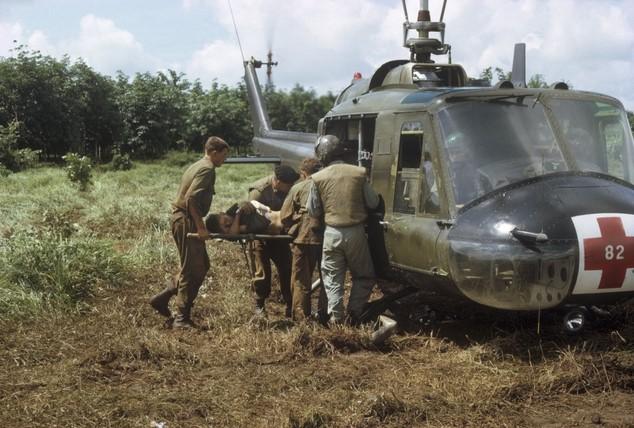
Francis Ford Coppola’s 1979 film Apocalypse Now is highly regarded as a cinematic masterpiece but is, of course, much more in its impact and continuing resonance. The film is emblematic of the Vietnam War, with its atrocities and absurdities, its brutalities and bravery.
There are now three versions of Coppola’s epic; Apocalypse Now: Final Cut was released this year with an endorsement from the 80-year-old director himself. It’s the movie as it was originally envisaged by Coppola, now freed of studio constraints. Three hours long, the film is mesmerising in its dramatic intensity and overwhelming in its cinematography and musical score.
Apocalypse Now is based in part on Joseph Conrad’s signature novel, Heart of Darkness, which gives the film its narrative thread. A US special forces commander, Colonel Walter E. Kurtz (Marlon Brando), has crossed into Cambodia with his loyal tribal army. His communications, once erratic, are now spiralling into insanity. At a meeting at Nha Trang, the US military hierarchy instructs the dissolute Captain Benjamin Willard (Martin Sheen) to terminate Kurtz’s command. A nameless CIA officer present at lunch utters the chilling overview: ‘Terminate with extreme prejudice.’ The die is cast.
A friend said to me recently that Apocalypse Now is a movie to be seen on the big screen. Very true, for the viewer can be immersed in its sweep and carried inexorably along by its hidden currents.
The journey upriver is worth of Homer. Willard encounters the glitter and raunch of a USO spectacle where Playboy Bunnies are helicoptered in to entertain the boisterous troops. A bridge is being rebuilt by night under lights and under fire, even though the North Vietnamese Army will destroy it again the following day. While the American garrison is keen to desert, the command in Saigon insists on being able to claim that the road is open. It’s a truly hopeless situation.
However, the battle scene which transports the viewer to a brilliant panorama of sight and sound emerges when Lieutenant Colonel Bill Kilgore (Robert Duvall) leads his air cavalry on an airborne assault upon a Viet Cong stronghold. Kilgore pays homage to George Armstrong Custer, even wearing 19th-century battle dress, but the manner of the assault is savage in its modernity.
On the beach, as the fighting continues, the dialogue assumes prominence. Aside from the surfing fantasies, the firefight produces the most memorable line of the film, from Kilgore: ‘I love the smell of napalm in the morning … It smells of victory.’
The irony of this assertion is not lost on anyone. The combat scenes are striking, not only for their shattering ferocity but for the chilling Wagnerian orchestral accompaniment in ‘The Ride of the Valkyries’ as the air cavalry descends upon the village from the sea. It has the impact of a primeval scream.
There may be no Wagnerian opera in the rubber plantation at Long Tan, but Danger Close: The Battle of Long Tan is an excellent Australian combat film centred on our army’s most famous and most costly encounter of the Vietnam War, with 18 Australians dead.
The film’s director, Kriv Stenders (Red Dog), stays close to the real history of the battle, which occurred in mid-August 1966 in a rubber plantation beyond the Australian (and New Zealand) base at Nui Dat in South Vietnam.
Delta Company is searching for Viet Cong mortars which have brought the Australian base under fire. Led by Major Harry Smith, convincingly played by Travis Fimmel, the company collides with a battalion of Viet Cong and a skirmish quickly develops into a battle for survival.
Veronika Jenet’s seamless editing delivers a battle film at the closest of quarters: this is an existential fight in which both sides display exemplary discipline and astonishing courage.
Richard Roxburgh delivers a compelling performance as the brigade commander, weighing up the threats to his troops as US airpower proves ineffective and Delta Company is sustained only by a superb artillery performance by the New Zealanders and courageous support from Royal Australian Air Force helicopters.
This is a Vietnam movie which does not leave the battlefield. The only note from the home front is the presence of Little Pattie and Col Joye performing in a concert at the Nui Dat base. They had to be evacuated as the battle developed. They were indefatigable entertainers for our troops and they deserve an honourable mention.
The climax of Apocalypse Now is Willard’s arrival at Kurtz’s charnel house of a base, deep in the Cambodian jungle. Another US officer sent to terminate Kurtz is there, but he has also crossed the line. Willard must actually confront himself.
Marlon Brando’s performance as the shattered special forces colonel remains magisterial. Kurtz does not need the American photographer (Dennis Hopper) to underline his imposing presence. Brando does this and much more with a simple glance or a few words.
Throughout the film, Michael Herr (Dispatches) offers a laconic commentary on the American War. As in the conversation which Willard has with the French planters, nothing is as clear or as definite as the politicians in Washington are asserting. The plantation holds nothing of the lush decadence of Régis Wargnier’s Indochine, but the widow, played by Aurore Clément, graces the screen with the same manner of discretion as Catherine Deneuve.
These films offer insight into the grim consequences of war. Vietnam was an incredibly bloody confrontation, as 245 Vietnamese dead at Long Tan makes clear. For new audiences, these movies tell a story about a war which deeply affected the cultures of both the United States and Australia and changed Vietnam irrevocably.